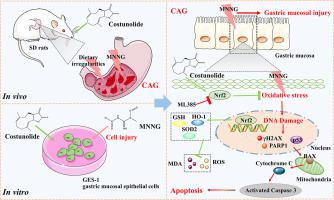当前位置:
X-MOL 学术
›
Phytomedicine
›
论文详情
Our official English website, www.x-mol.net, welcomes your
feedback! (Note: you will need to create a separate account there.)
Costunolide ameliorates MNNG-induced chronic atrophic gastritis through inhibiting oxidative stress and DNA damage via activation of Nrf2
Phytomedicine ( IF 6.7 ) Pub Date : 2024-04-02 , DOI: 10.1016/j.phymed.2024.155581 Ruixuan Wang 1 , Youdong Zhao 1 , Lei Zhou 1 , Fei Lin 1 , Meiqi Wan 1 , Anna Gan 1 , Bo Wu 1 , Tingxu Yan 1 , Ying Jia 1
Phytomedicine ( IF 6.7 ) Pub Date : 2024-04-02 , DOI: 10.1016/j.phymed.2024.155581 Ruixuan Wang 1 , Youdong Zhao 1 , Lei Zhou 1 , Fei Lin 1 , Meiqi Wan 1 , Anna Gan 1 , Bo Wu 1 , Tingxu Yan 1 , Ying Jia 1
Affiliation

|
Chronic atrophic gastritis (CAG) is a chronic digestive disease. Modern research has revealed substantial evidence indicating that the progression of CAG is closely linked to the occurrence of oxidative stress-induced DNA damage and apoptosis in the gastric mucosa. Additionally, research has indicated that Costunolide (COS), the primary active compound found in Aucklandiae Radix, a traditional herb, exhibits antioxidant properties. Nevertheless, the therapeutic potential of COS in treating CAG and its molecular targets have not yet been determined. The objective of this research was to explore the potential gastric mucosal protective effects and mechanisms of COS against N-Methyl-N´-nitro-N-nitrosoguanidine (MNNG)-induced CAG. Firstly, the MNNG-induced rat CAG model was established . Occurrence of CAG was detected through macroscopic examination of the stomachs and H&E staining. Additionally, we assessed oxidative stress, DNA damage, and apoptosis using biochemical detection, Western blot, immunohistochemistry and immunofluorescence. Then, an model was developed to induce MNNG-induced damage in GES-1 cells, and the occurrence of cell damage was determined by Hoechst 33,342 staining and flow cytometry. Finally, the key targets of COS for the treatment of CAG were identified through molecular docking, cellular thermal shift assay (CETSA), and inhibitor ML385. studies demonstrated that COS promotes the expression of Nrf2 in gastric tissues. This led to an increased expression of SOD, GSH, HO-1, while reducing the production of MDA. Furthermore, COS inhibited DNA damage and apoptosis by suppressing the expression of γH2AX and PARP1 in gastric tissues. studies showed that COS effectively reversed apoptosis induced by MNNG in GES-1 cells. Additionally, COS interacted with Nrf2 to promote its expression. Furthermore, the expression levels of SOD, GSH, and HO-1 were augmented, while the generation of ROS and MDA was diminished. Our results indicate that COS exhibits therapeutic effects on CAG through the promotion of Nrf2 expression and inhibition of oxidative stress and DNA damage. Therefore, COS has the potential to provide new drugs for the treatment of CAG.
中文翻译:

Costunolide 通过激活 Nrf2 抑制氧化应激和 DNA 损伤,改善 MNNG 诱导的慢性萎缩性胃炎
慢性萎缩性胃炎(CAG)是一种慢性消化系统疾病。现代研究已揭示大量证据表明CAG的进展与氧化应激诱导的胃粘膜DNA损伤和细胞凋亡的发生密切相关。此外,研究表明木香内酯 (COS) 是传统草药木香中发现的主要活性化合物,具有抗氧化特性。然而,COS 治疗 CAG 的治疗潜力及其分子靶点尚未确定。本研究的目的是探讨 COS 对 N-甲基-N'-硝基-N-亚硝基胍 (MNNG) 诱导的 CAG 的潜在胃粘膜保护作用和机制。首先,建立MNNG诱导的大鼠CAG模型。通过胃的宏观检查和H&E染色来检测CAG的发生。此外,我们还使用生化检测、蛋白质印迹、免疫组织化学和免疫荧光评估了氧化应激、DNA 损伤和细胞凋亡。然后,开发了一个模型来诱导 MNNG 诱导的 GES-1 细胞损伤,并通过 Hoechst 33,342 染色和流式细胞术确定细胞损伤的发生。最后,通过分子对接、细胞热位移分析(CETSA)和抑制剂ML385确定了COS治疗CAG的关键靶点。研究表明,COS 促进胃组织中 Nrf2 的表达。这导致 SOD、GSH、HO-1 的表达增加,同时减少 MDA 的产生。此外,COS通过抑制胃组织中γH2AX和PARP1的表达来抑制DNA损伤和细胞凋亡。研究表明,COS 可有效逆转 MNNG 诱导的 GES-1 细胞凋亡。 此外,COS 与 Nrf2 相互作用以促进其表达。此外,SOD、GSH 和 HO-1 的表达水平增加,而 ROS 和 MDA 的产生减少。我们的结果表明,COS 通过促进 Nrf2 表达、抑制氧化应激和 DNA 损伤对 CAG 发挥治疗作用。因此,COS有潜力为CAG的治疗提供新药。
更新日期:2024-04-02
中文翻译:

Costunolide 通过激活 Nrf2 抑制氧化应激和 DNA 损伤,改善 MNNG 诱导的慢性萎缩性胃炎
慢性萎缩性胃炎(CAG)是一种慢性消化系统疾病。现代研究已揭示大量证据表明CAG的进展与氧化应激诱导的胃粘膜DNA损伤和细胞凋亡的发生密切相关。此外,研究表明木香内酯 (COS) 是传统草药木香中发现的主要活性化合物,具有抗氧化特性。然而,COS 治疗 CAG 的治疗潜力及其分子靶点尚未确定。本研究的目的是探讨 COS 对 N-甲基-N'-硝基-N-亚硝基胍 (MNNG) 诱导的 CAG 的潜在胃粘膜保护作用和机制。首先,建立MNNG诱导的大鼠CAG模型。通过胃的宏观检查和H&E染色来检测CAG的发生。此外,我们还使用生化检测、蛋白质印迹、免疫组织化学和免疫荧光评估了氧化应激、DNA 损伤和细胞凋亡。然后,开发了一个模型来诱导 MNNG 诱导的 GES-1 细胞损伤,并通过 Hoechst 33,342 染色和流式细胞术确定细胞损伤的发生。最后,通过分子对接、细胞热位移分析(CETSA)和抑制剂ML385确定了COS治疗CAG的关键靶点。研究表明,COS 促进胃组织中 Nrf2 的表达。这导致 SOD、GSH、HO-1 的表达增加,同时减少 MDA 的产生。此外,COS通过抑制胃组织中γH2AX和PARP1的表达来抑制DNA损伤和细胞凋亡。研究表明,COS 可有效逆转 MNNG 诱导的 GES-1 细胞凋亡。 此外,COS 与 Nrf2 相互作用以促进其表达。此外,SOD、GSH 和 HO-1 的表达水平增加,而 ROS 和 MDA 的产生减少。我们的结果表明,COS 通过促进 Nrf2 表达、抑制氧化应激和 DNA 损伤对 CAG 发挥治疗作用。因此,COS有潜力为CAG的治疗提供新药。


















































 京公网安备 11010802027423号
京公网安备 11010802027423号